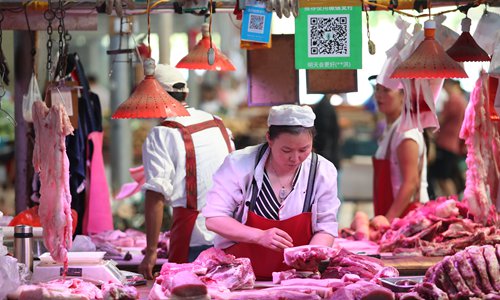China taps state pork reserves, to release 10,000 tons for steady supply
By Wang Cong, Zhang Han and Chen Qingqing Source:Global Times Published: 2019/9/19 21:08:41 Last Updated: 2019/9/20 14:52:01

Chinese vendors sell pork in a market in Kunming, capital of Southwest China's Yunnan Province in June. Photo: IC
China on Thursday moved to tap its state pork reserves to ensure steady supply ahead of the National Day holiday peak season, as pork prices have been skyrocketing from strained supplies caused by the outbreak of African swine fever (ASF).
The Ministry of Commerce (MOFCOM) said it released 10,000 tons of pork from the central government's reserves into the market as part of a contingency plan to manage periodical fluctuations in pork prices.
The move was meant to increase pork supply and ensure meat supply during the seven-day holiday, according to a MOFCOM statement. It noted that pork prices in the country have increased significantly, though demand is dropping.
On Wednesday, wholesale pork prices at major markets rose by 0.1 percent from the previous day, but 1.3 percent higher than September 10.
"The MOFCOM will closely monitor changes to pork prices and supply and demand… and continue to release state pork reserves when appropriate to ensure supply," the statement said.
Faced with rising prices and strained supplies, some local governments have already tapped into their reserves to ensure market stability. On Saturday, the provincial government of East China's Zhejiang Province released a batch of pork from its reserves priced 30 percent lower than market prices, according to media reports. It was unclear how much pork the province released.
Jinan city, capital of East China's Shandong Province, has released 1,500 tons of pork reserves in two batches to 44 city market places since September 12, the Economic Daily reported.
Ma Wenfeng, a senior analyst at Beijing Orient Agribusiness Consultancy, told the Global Times on Thursday that for food like grain and pork, using reserves is a common practice to rein in prices.
The pork released from the reserves comes from imports from countries like Denmark, Germany, France and the US, according to a document released on the China Merchandise Reserve Management Center's website.
Although 10,000 tons is small compared to the country's total consumption, it roughly equals one week's worth of wholesale market trade in big cities, which means it will hold back pork prices before the National Day holidays, Ma said.
In 2018, China consumed 55.95 million tons of pork, the 21st Century Business Herald reported.
Stabilizing pork prices will help maintain the CPI - a gauge of inflation - at reasonable levels, as the surge in pork prices has already driven up overall inflation in August, according to the latest data.
The CPI increased 2.4 percent year-on-year in the first eight months of 2019, and was up 2.8 percent in August, mainly driven by food prices, the National Bureau of Statistics said at a press conference on Monday.
Food prices rose 10 percent year-on-year in August, when pork prices rose nearly 50 percent, becoming a major factor in the CPI's growth.
However, unleashing the reserves is only a temporary solution, and increasing domestic hog production is the way to address the supply-and-demand issue, Ma noted.
"It is necessary and urgent to encourage farmers to return to the industry after many pig farms were shut down due to the swine fever," he said.
In a sign that authorities have already acknowledged the root of the problem, the ministries of finance and agriculture earlier this month issued joint measures, including subsidies for farmers whose pigs were killed due to ASF, expanding loans to pig farms and increasing incentives for large pork producers.
In a sign that authorities have already acknowledged the root of the problem, the ministries of finance and agriculture earlier this month issued joint measures, including subsidies for farmers whose pigs were killed due to ASF, expanding loans to pig farms and increasing incentives for large pork producers.